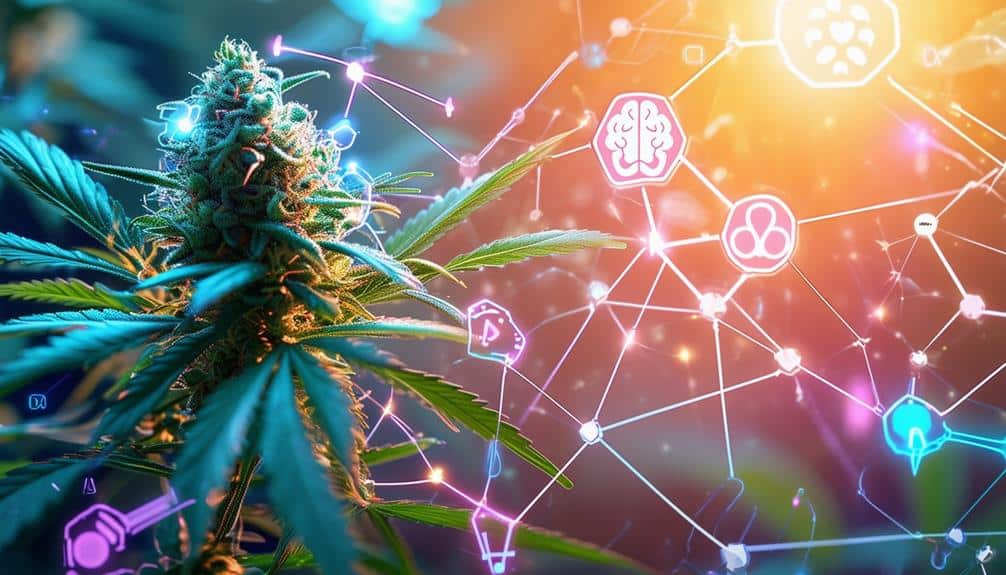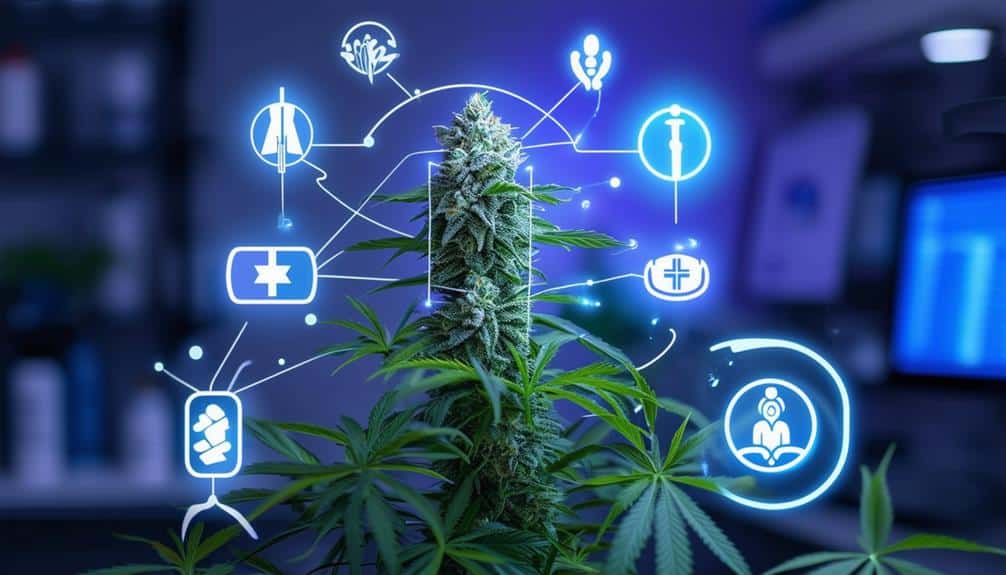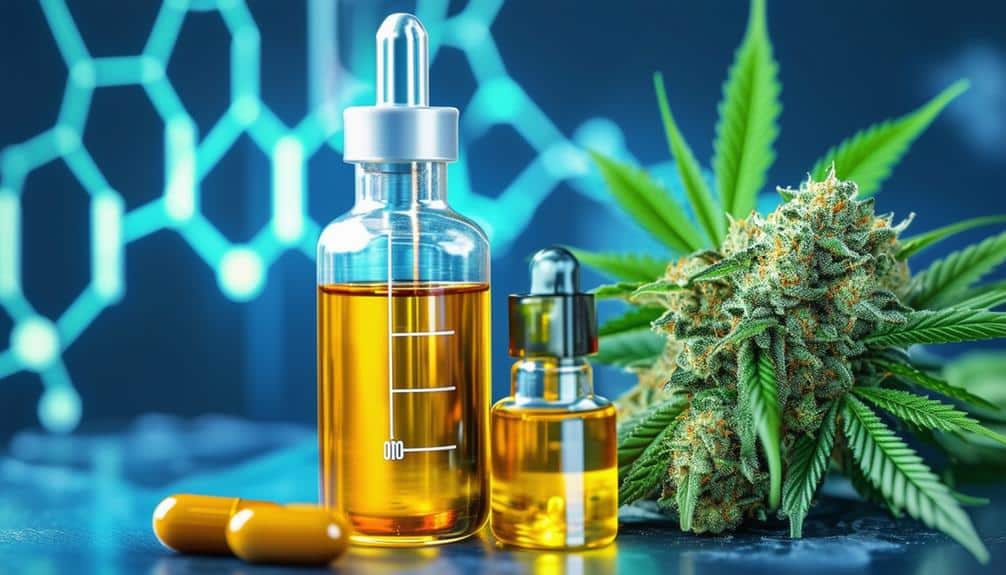Just as Pandora opened a box of complexities, understanding the science behind medical marijuana can seem overwhelming. However, it’s essential for Delaware patients seeking effective treatment. You’ll discover how cannabinoids like THC and CBD interact with your body’s endocannabinoid system, influencing everything from mood to pain management. The role of terpenes in enhancing therapeutic benefits adds another layer of complexity. By learning about these elements, you can make informed decisions and tailor your treatment plans. But what specific conditions can it treat, and how do you navigate potential side effects? Let’s explore further.
Table of Contents
Understanding Cannabinoids

Understanding cannabinoids is crucial because they’re the active compounds in medical marijuana that interact with your body’s endocannabinoid system. Cannabinoids like THC and CBD bind to cannabinoid receptors found throughout your body, including the brain and immune system. These interactions can produce various effects such as altering mood, perception, and pain sensation.
The psychoactive properties of THC are well-known but it’s vital to recognize that cannabinoids also offer significant therapeutic benefits. For instance, CBD has been shown to reduce inflammation and alleviate anxiety without producing a ‘high.’ These therapeutic benefits make cannabinoids valuable in treating conditions like chronic pain, epilepsy, and multiple sclerosis.
The entourage effect further amplifies these benefits. This phenomenon occurs when various cannabinoids, terpenes, and other compounds in marijuana work together synergistically. By using whole-plant extracts rather than isolated compounds, you can achieve a more inclusive therapeutic outcome.
This synergy is crucial for maximizing the potential benefits of medical marijuana.
The Endocannabinoid System
The endocannabinoid system (ECS) plays a pivotal role in regulating various physiological processes, including mood, pain sensation, and immune response. Understanding the ECS can help you appreciate how medical marijuana works in the body.
The ECS consists of cannabinoid receptors, endocannabinoids produced naturally by your body, and enzymes that break them down. Two primary cannabinoid receptors, CB1 and CB2, are critical components of the ECS. CB1 receptors are mainly found in the brain and central nervous system influencing mood and pain perception.
CB2 receptors on the other hand are mainly located in peripheral tissues such as the immune system and help modulate inflammation and immune response. Activation of these receptors by endocannabinoids or cannabinoids from medical marijuana can trigger various biological responses.
For instance neuroprotection mechanisms are engaged when CB1 receptors are activated potentially protecting neurons from damage and supporting cognitive functions. Similarly, CB2 receptor activation can reduce inflammation offering relief from chronic pain and autoimmune conditions.
THC Vs. CBD

When comparing THC and CBD it’s vital to acknowledge their distinct effects and therapeutic advantages.
THC or tetrahydrocannabinol is the psychoactive element of cannabis that induces the ‘high’ commonly linked with recreational use. On the other hand, CBD or cannabidiol is non-psychoactive and is mainly sought after for its health benefits. Both substances interact with the endocannabinoid system but in varying manners resulting in different consequences.
Medical research shows that THC can be effective in pain relief, stimulating appetite, and reducing nausea making it advantageous for patients undergoing chemotherapy. However its legal standing varies and it may be subject to stricter regulations due to its psychoactive characteristics.
Conversely CBD has garnered attention for its potential to alleviate anxiety inflammation and seizures without the intoxicating impacts of THC. Its legal status is often more relaxed contributing to its widespread acceptance as a therapeutic choice.
Understanding the disparities between THC and CBD enables you to make well-informed decisions regarding medical marijuana.
While both provide significant health benefits it’s essential to take into account their legal status and individual effects to guarantee the best possible outcomes for patients.
Terpenes and Their Effects
Terpenes, aromatic compounds found in cannabis play a significant role in both the plant’s therapeutic effects and its distinct scent. These compounds are crucial in aroma therapy influencing mood and well-being through their scents.
Each terpene has unique properties; for example limonene offers a citrusy aroma known for uplifting effects while myrcene with an earthy scent is often associated with relaxation.
Understanding terpenes is vital because they contribute to the entourage effect. This concept suggests that terpenes work synergistically with cannabinoids like THC and CBD enhancing their therapeutic benefits. Research indicates that interaction between terpenes and cannabinoids can impact efficacy of medical marijuana treatments making it important to consider terpene profiles when selecting cannabis products.
For those serving others especially in healthcare recognizing the role of terpenes can improve patient outcomes. By tailoring cannabis treatments to include specific terpene profiles you can address individual needs more effectively.
Always keep in mind the evidence-based benefits of terpenes to optimize the therapeutic potential of medical marijuana ensuring that patients receive thorough and effective care.
Medical Conditions Treated

Many medical conditions benefit from the healing effects of medical cannabis supported by growing clinical evidence. Chronic pain management is one of the most common uses as cannabinoids in cannabis interact with receptors in your brain and body to alleviate pain. This can greatly enhance quality of life for patients suffering from conditions like arthritis or fibromyalgia.
Neurological disorders also see positive outcomes. For instance, medical cannabis has shown promise in reducing seizures in epilepsy patients and alleviating symptoms of multiple sclerosis. The anti-inflammatory and neuroprotective properties of cannabinoids contribute to these effects.
In cancer treatment, medical cannabis helps manage chemotherapy-induced nausea and vomiting making the challenging treatment process more tolerable. Additionally it can stimulate appetite aiding prevention of severe weight loss.
Mood disorders like anxiety and depression can also be alleviated with medical cannabis. Certain strains have been found to reduce anxiety levels and improve mood although effects can vary depending on individual and specific strain used.
Understanding these healing benefits can guide you in serving patients more effectively ensuring they receive the thorough care they deserve.
Methods of Consumption
Patients have various ways to consume medical cannabis each with distinct advantages and crucial factors for effectiveness and safety. Vaping is a popular choice due to its rapid onset of effects. However, it’s vital to be mindful of vaping risks including potential lung irritation and exposure to harmful additives. Always opt for products from reputable sources to minimize these risks.
Oral tinctures provide an alternative option. They’re easy to dose and have a relatively quick onset typically within 15 to 45 minutes. Tinctures are discreet allowing consumption without inhalation. This approach can be particularly advantageous for patients with respiratory issues.
Topical applications like creams and patches are excellent for localized pain or inflammation. They offer targeted relief without the psychoactive effects linked to other methods making them suitable for patients requiring relief while carrying out daily activities.
Suppositories present another specialized approach. They ensure rapid absorption and are beneficial for patients unable to orally consume cannabis. This method can be especially effective for conditions impacting the lower abdomen or pelvic region.
Each approach comes with its own set of advantages and disadvantages. It’s vital to evaluate your specific medical conditions and lifestyle when selecting the most suitable consumption method.
Dosage and Titration

Understanding the best dosage and titration of medical marijuana is vital in maximizing its therapeutic benefits while minimizing potential side effects. You’ll need to focus on patient education and seek physician guidance to navigate this process effectively. Each patient’s response to medical marijuana can vary significantly so individualized treatment plans are essential.
Starting with a low dose and making gradual adjustments can help you find the best balance. Physicians often recommend the ‘start low, go slow’ approach which involves slowly increasing the dosage until desired therapeutic effects are achieved without adverse reactions. This method not only guarantees safety but also helps in identifying the minimum effective dose for each patient.
Patient education is important in this process. You should understand how different strains concentrations and consumption methods can influence effects of medical marijuana. Working closely with your physician will help you make informed decisions and adjustments as needed.
Potential Side Effects
Despite its therapeutic benefits, medical marijuana can also produce side effects that patients should be aware of. Common short-term effects include dizziness dry mouth and changes in appetite. These symptoms can often be managed effectively with adjustments in dosage or by choosing a different strain. However it’s pivotal to monitor how your body responds and consult with your healthcare provider regularly.
Long-term risks associated with medical marijuana use are an area of ongoing study. Some research suggests potential impacts on memory and cognitive function especially with prolonged use. Additionally there’s evidence indicating a risk of developing dependency or tolerance necessitating higher doses to achieve same therapeutic effect.
To mitigate these risks you should follow a structured treatment plan and keep open communication with your healthcare provider. They can help you manage symptoms and adjust your dosage as needed. Monitoring your use and being mindful of any changes in health are essential steps ensuring that medical marijuana remains safe effective part of your treatment regimen.
Legal Considerations in Delaware

Understanding the legal landscape of medical marijuana in Delaware requires a clear grasp of state-specific regulations and compliance requirements. First, you need to recognize patient rights under Delaware’s medical marijuana laws. Eligible patients must have a qualifying condition such as chronic pain or PTSD and obtain a medical marijuana card through a state-approved application process. This card grants you the right to purchase and use medical marijuana within certain limits ensuring you’re protected from legal repercussions when following state guidelines.
Next consider dispensary regulations which are essential for both patients and providers. Delaware has stringent rules governing how dispensaries operate including security measures product testing and inventory tracking. Dispensaries must ensure that products are safe comply with state standards which in turn helps you receive high-quality medical marijuana. As a patient understanding these regulations can help you make informed choices about where to obtain your medication.
Compliance is crucial. You must always carry your medical marijuana card stay informed about quantity limits to avoid legal issues. By understanding these legal considerations, you can navigate Delaware’s medical marijuana system efficiently responsibly ensuring your rights are respected and health needs met.
Research and Future Directions
Ongoing research into efficacy safety of medical marijuana continues shaping future treatment options for patients in Delaware. Clinical trials are vital understanding how best serve patient needs examining different dosages strains delivery methods maximizing therapeutic benefits while minimizing adverse effects. By participating in clinical trials, contribute growing body evidence informs patient outcomes treatment protocols.
Legislative changes also play pivotal role evolving landscape of medical marijuana new research emerges lawmakers likely adjust regulations better accommodate patient needs public safety. Staying informed about these changes helps navigate legal framework advocate policies improve access efficacy.
Public perception another influential factor as medical marijuana becomes more widely accepted stigma decreases potentially leading increased funding research broader legislative support. Educating others scientifically-backed benefits can shift public opinion foster more supportive environment for patients.
Conclusion
As you navigate the path of medical marijuana remember understanding cannabinoids terpenes endocannabinoid system is your guiding light.
Differentiating THC from CBD helps tailor your treatment while being aware of medical conditions treated dosage side effects keeps you on track.
Stay updated on Delaware’s legal landscape and research advancements. This knowledge isn’t just power—it’s your compass guiding you towards better health well-being with evidence-based precision.
If you’re curious to learn more or have any questions why not visit us at Cannabis Docs of Delaware? We’re here help every step way.
Feel free to give us a call at (855) 420-6797. We’d love chat provide all information need.

